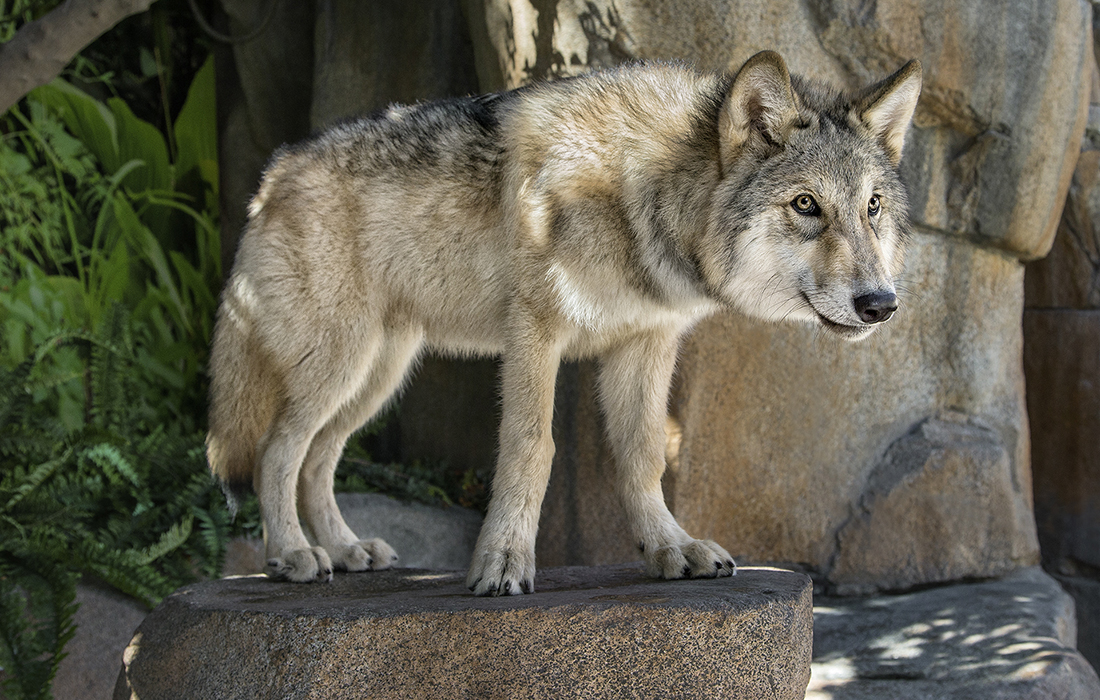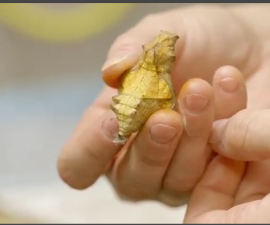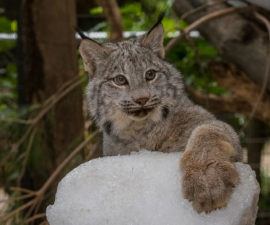Summer is a great time to discover wild and woof-y members of the canid family at the Zoo and Safari Park.
BY Eston Ellis
Photography by Ken Bohn
Videography by Maria Bernal-Silva
In some ways, they act like domesticated dogs—but mostly, the members of the Canidae family that you’ll see at the San Diego Zoo and Safari Park like to keep it wild. From dholes and maned wolves to New Guinea singing dogs and gray wolves, canids are efficient hunters, playful as youngsters, and vocal animals that can communicate over long distances. Some, like dholes and wolves, are pack members that are strongly devoted to a large family group. Others, like maned wolves and New Guinea singing dogs, lead solitary lives as adults on their own or in monogamous pairs.
While the Canidae family’s Vulpini tribe includes foxes (see the April 2016 ZOONOOZ article “Feeling Foxy”), the Canini tribe of canids includes domesticated dogs, wild dogs, wolves, and maned wolves—which despite their common name are quite distinct from true wolves. Although the wild Canini tribe members may remind you of the dogs we live with as pets—especially when they are playing, or when their tongues are hanging out of an open mouth that seems to smile—these canines live entirely different lives. They may make a lot of different sounds—including howls, yips, whistles, growls, or yodels, depending on the species—but many canids don’t bark. Still, these canines enjoy chewing on a bone just like pet dogs; and while they may like to play with sticks, they definitely won’t fetch one and bring it back.
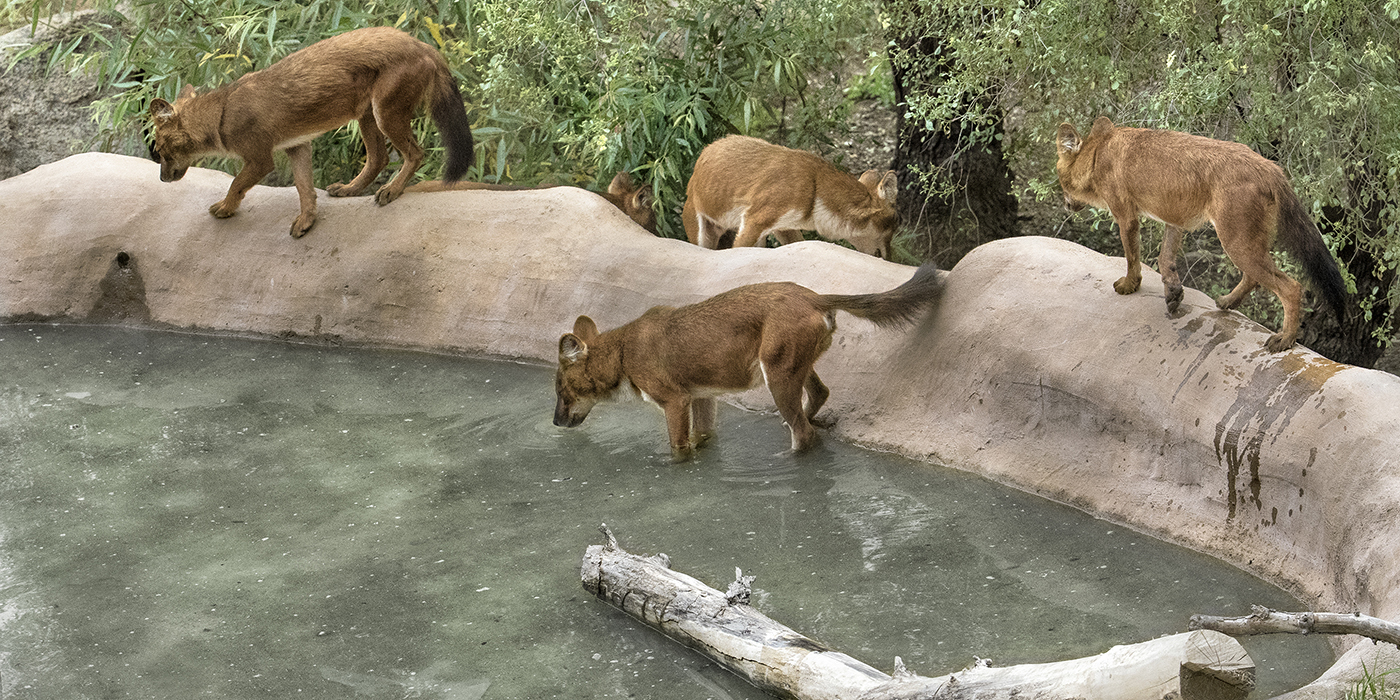
 How many times heavier than a dhole its prey can be, when dholes are hunting together as a pack
How many times heavier than a dhole its prey can be, when dholes are hunting together as a pack
Meet the Pack
Dholes Cuon alpinus, sometimes called Asiatic wild dogs, are native to eastern and southern Asia. They have reddish-brown fur, often with white bellies, and long legs; and they are about the size of a German shepherd. They are endangered, with only little over 2,200 mature, breeding-age dholes estimated in the wild. Threats to their survival include habitat loss, disease transmission from domestic dogs, and persecution by humans who view them as pests that prey on livestock.
At the Safari Park, the past six months have been “dog days,” thanks to a welcome population explosion in our dhole breeding program, located at an off-exhibit area of the Park. The pack, which previously numbered 6 dholes, jumped to 16 in just one day—fittingly, on Leap Day, February 29, 2016. A second pack of 7 dholes lives nearby, in the 3-acre former tiger exhibit in the Asian Savanna; and three other pair live at the breeding center, bringing the total number at the Park to 29.
Dholes are naturally wary, said Melodi Tayles, a lead keeper at the Safari Park. Pups duck into their den at any hint of something they haven’t seen or heard before, and the adults are quick to vocalize with a chattering alarm call. Or they may growl and posture protectively if they see something out of the ordinary. Dholes don’t bark, but you might hear them whistle or scream. “They’re suspicious by nature,” Melodi said.
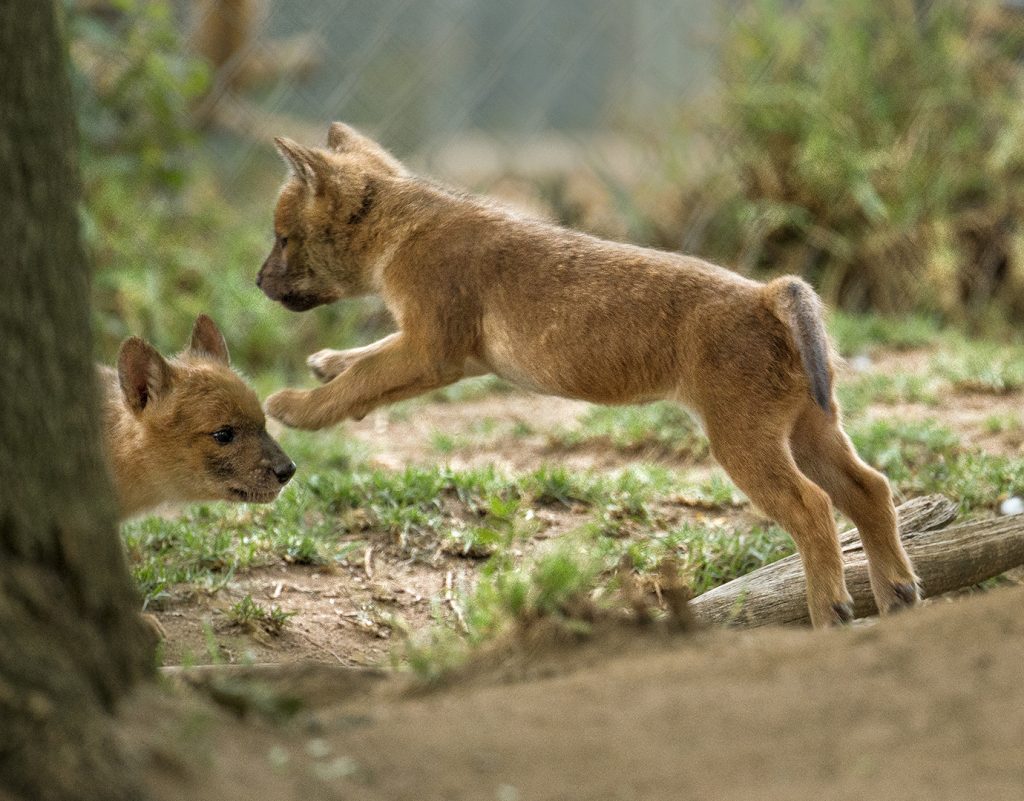
LET’S PLAY
While dholes differ from domesticated dogs in many ways, one thing they have in common is that they love to play—with siblings, with sticks, or in a pool of water.
 Number of feet a dhole can jump, straight up into the air
Number of feet a dhole can jump, straight up into the air
Anatomically, dholes have two fewer molars than domestic dogs (with only two on each side of their lower jaw, instead of three). Dholes typically don’t wag their tails, but they use them to indicate their position in the pack: a tail that is straight up or over its back indicates a dominant dhole, while a submissive dhole’s tail will be as far down as it can be. However, they have one big thing in common with domesticated dogs: “Dholes play like crazy,” Melodi said, adding that they like playing with sticks and they love playing in water. “Give a dhole a pool, and you’ll have one happy dog.”
Dholes can jump to heights up to seven feet, and they are great climbers. At the Park, they love climbing on woodpiles, tunnels, crates, benches, and shade structures. Surprisingly, they even climb trees, walking gracefully up and down the thickest branches.
The dhole breeding program at the Park, which aims to boost the numbers of this endangered canid, is one of only three in the nation. Others are located at The Wilds in Ohio and the Minnesota Zoo. The San Diego Zoo Safari Park has more dholes than any other facility in the United States and is the leader in dhole breeding. “We have also collaborated with dhole researchers, who are studying them in the wild,” said Autumn Nelson, animal care supervisor, Collections Husbandry Sciences, mammal department. “Through conservation research, we want to learn as much as we can about the wild population, to apply that knowledge to those in managed care. Just when I think we have dholes figured out, they surprise us.”
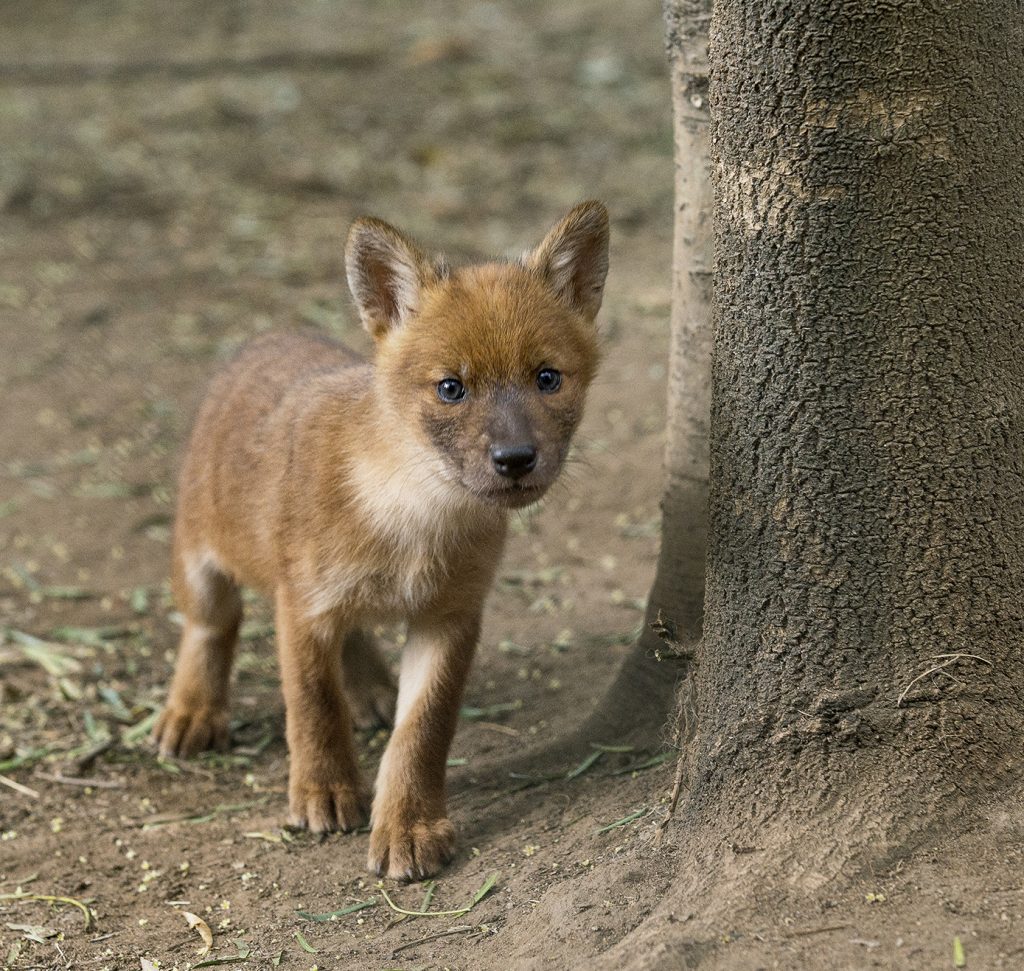
WHAT’S THAT?
Even as pups, dholes are wary of anyone they haven’t seen before or anything unusual in their surroundings.
When the current litter of dhole pups was born at the Park in February, there was a camera inside the den. But clever six-year-old alpha mom Tikka Masala managed to stay away from it, giving birth far in the back, Melodi recalled. “We didn’t know how many we had, at first,” she said. “First, we thought that we had three pups, then four, then maybe as many as six. Then, we finally saw the whole litter—and it was 10. That’s the largest dhole litter ever in the United States.”
There are three male pups—Apollo, Kito, and Rowan—and seven females: Sadie, Violet, Alula, Berezi, Scarlet, Thea, and Ushki. “Ushki is the toughest little girl we have,” Melodi said. “She’s the fighter of the group—always stirring things up. Boys Apollo and Kito are the bravest, which is unusual, because usually the females are.” Females have to be strong and independent, she explained, because while males usually remain in their original pack for their entire lives, females leave at around age three to start their own packs.
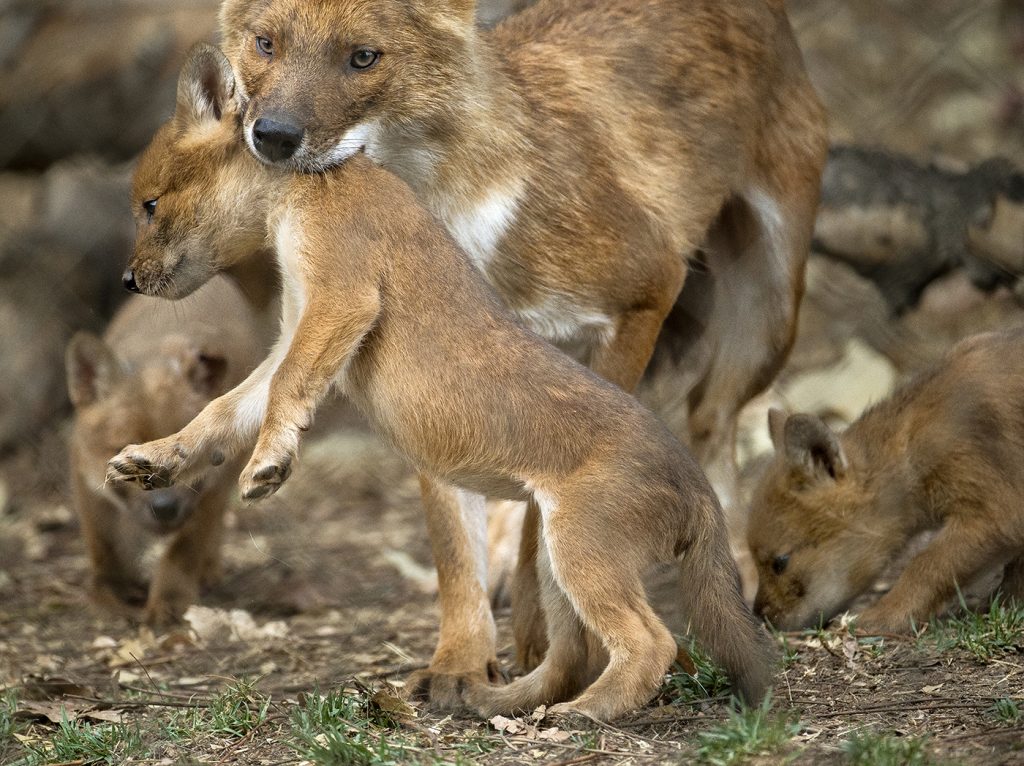
BRINGING UP PUPS
A mother dhole with a large litter of pups has a lot to keep her busy, but fortunately, the other adults in the pack also help care for the youngsters.
 Pounds of meat the Park’s 16-member dhole pack consumes each day
Pounds of meat the Park’s 16-member dhole pack consumes each day
The pups’ father—Nima, the six-year-old alpha male who heads the pack—is very stoic, Melodi said. Tikka, formerly a somewhat nervous dhole, has calmed down considerably after increasing the size of her pack: “Family life has worked for her.”
In their first few weeks, Tikka took care of the pups’ every need, Melodi said. But as they got a little older, she was happy to let the rest of the pack help out. The other pack members include Tikka’s previous litter: one-year-old males Basundi and Kallu, and females Mishti Doi and Tandori. The pups engage in a “kissing” or “food-begging” behavior, licking at the adults’ mouths to let the grown-ups know they are hungry. Adults cache and regurgitate food to feed the pups.
In the wild, dholes hunt as a pack, and they are quite skilled at bringing down large animals, like deer. The pack always feeds the pups first, then the adults eat. At the Park, the dholes eat meat and get bones to chew on, along with a thawed frozen rabbit once a week.
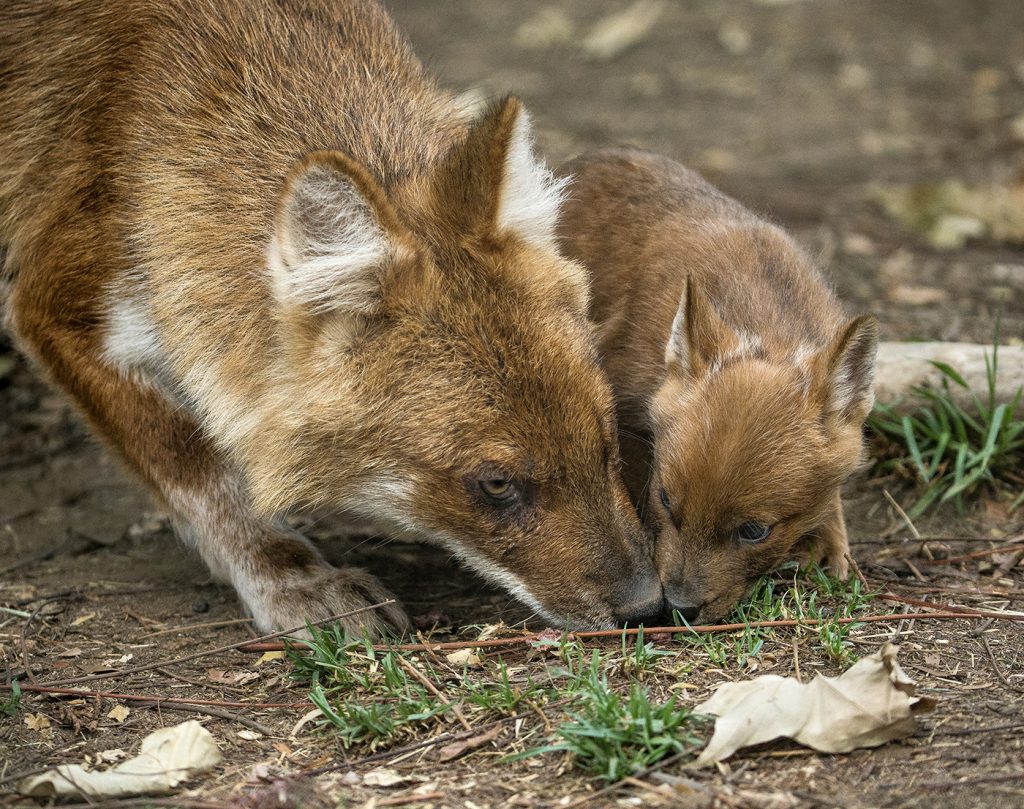
NOT REALLY A KISS
Dhole pups engage in “food-begging” behavior, licking at an adult’s mouth to show that they’re hungry.
The dholes in both the breeding center and the Asian Savanna habitat get regular enrichment, which keeps them stimulated and active, and allows them to exhibit natural behaviors. The Asian Savanna pack includes one female and seven males: alpha Sanuk, Beni, Jetsan, Lucius, Torma, Katsu, Kono, and Yoshi. “We try to expand their diet; we hang stuff in trees, and that includes hiding meat in the trees,” said Mary Weber-Evans, a mammal keeper at the Safari Park. “It may be a seven- or eight-foot jump, but they come, jump up, and get it. They find everything. And when they all get a bone, they vocalize and share the bones.”
The pack in the dhole breeding program is off exhibit except during customized Ultimate Safari tours, and the pack in the Asian Savanna is currently shown to guests during special behind-the-scenes tours. Plans are in the works to offer more viewing opportunities in the future. With only two other zoos in the US currently exhibiting dholes, few people have ever seen these endangered wild dogs. “We hope other zoos will start to exhibit dholes,” Autumn said. “They are unique—and rare—now. As our population grows, and we continue to work with other facilities, we look forward to introducing these amazing animals to more people.”
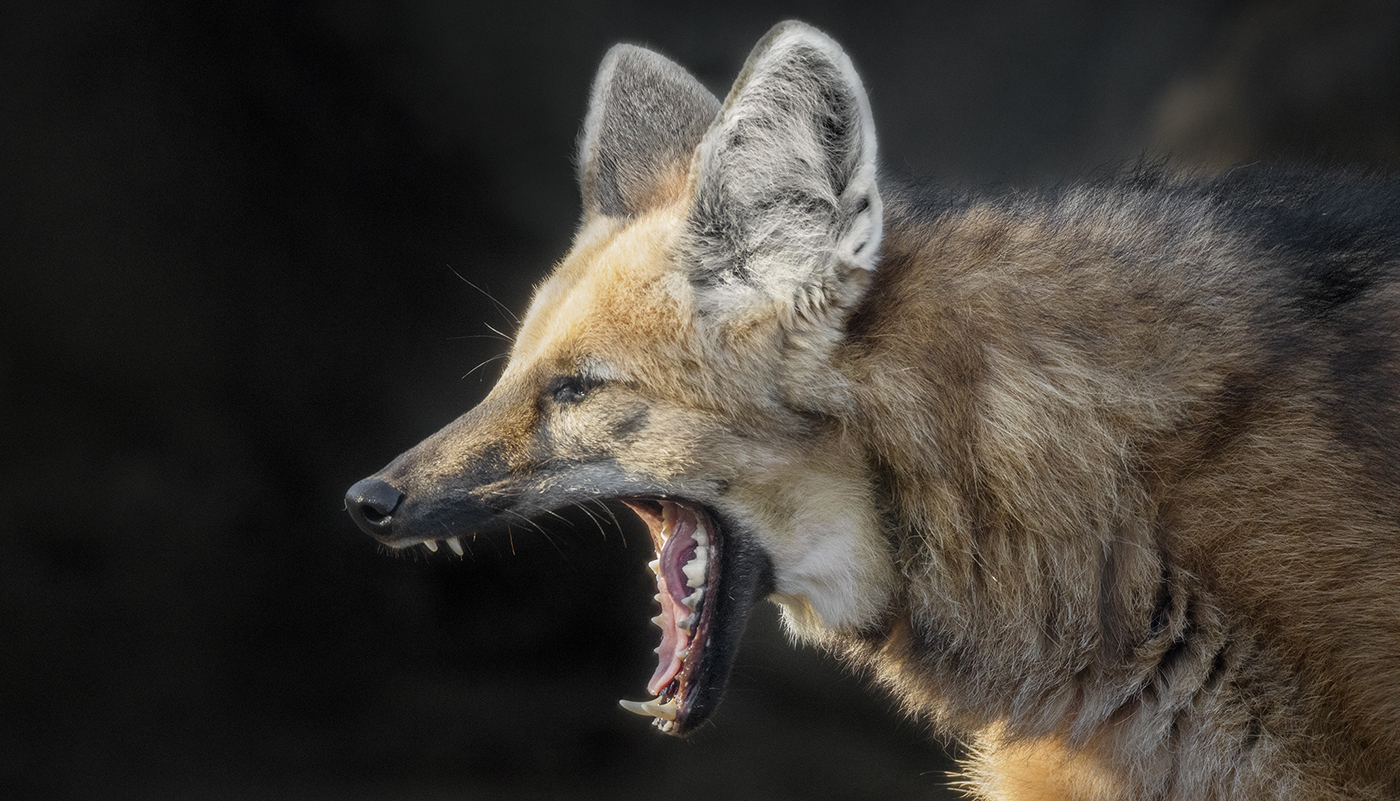
 Square miles of an average maned wolf pair’s home range in the wild
Square miles of an average maned wolf pair’s home range in the wild
The Wolf That Isn’t
Along with dholes, several other canids make their home at the Zoo and Safari Park. One of the most unusual is the maned wolf.
Native to forests and grasslands of South America, the maned wolf Chrysocyon brachyurus is not a wolf at all. Two maned wolves—sisters Jamie and Jasmine—can be seen in their exhibit at the Zoo’s Northern Frontier, near Skyfari West. A keeper talk, given daily at 11:30 a.m., offers guests insights into the lives of these unusual canids, along with husbandry training demonstrations.
This long-legged wild dog has a foxlike appearance, with a reddish-brown coat. It gets its name from the mane along its back that stands up whenever a threat is perceived. Unlike wolves, which live in packs, the maned wolf is a solitary animal that hunts alone. Although adults do pair up with a mate and remain monogamous—sharing a range as large as 17 square miles—they only come together to breed and raise pups.
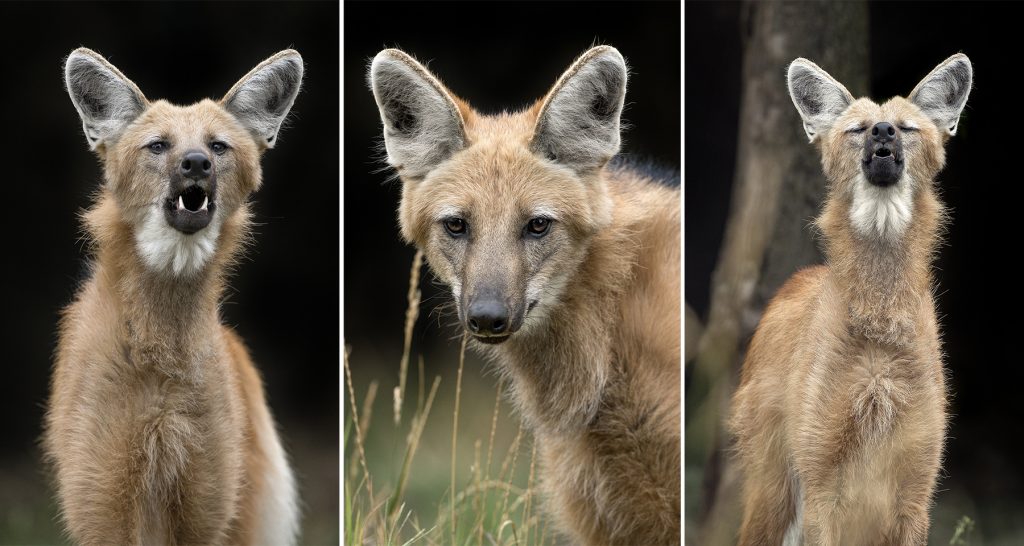
NOW HEAR THIS
Maned wolves have three very different vocalizations—a high-pitched whine they often use as a greeting, a protective growl, and a deep single bark, often used at dusk.
 Percentage of maned wolves’ diet that consists of vegetation
Percentage of maned wolves’ diet that consists of vegetation
Maned wolves also differ from wolves in what they eat: about 75 percent of their diet is vegetarian—consisting mostly of a tomato-like fruit called lobeira in their native habitat—and about 25 percent includes birds, eggs, insects, reptiles, and small mammals. At the Zoo, they eat nutritionally balanced kibble and enjoy mouse treats during training sessions.
Maned wolves have three distinct vocalizations: a high-pitched whine, often used as a greeting; a protective growl; and a deep single bark, which they often use at dusk. Other communication is done through scent. They mark their territory, leaving urine as a signal to other maned wolves to either stay away, or to be aware that a breeding-ready partner is available.
In the wild, maned wolves face threats through habitat loss and are often killed by humans protecting livestock or taken for body parts used in folk remedies. The maned wolf is currently listed as vulnerable on the International Union for Conservation of Nature (IUCN) Red List of Threatened Species.
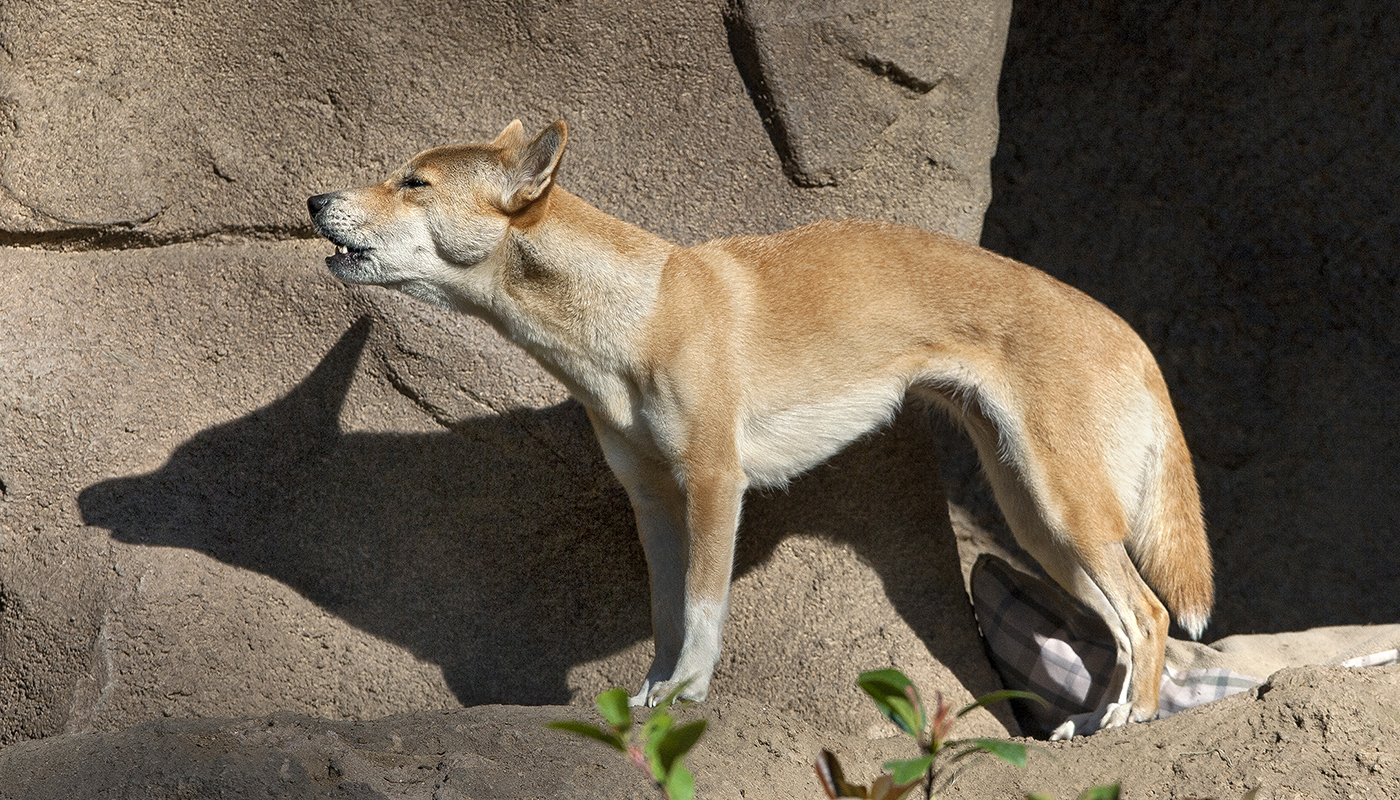
 Age of maturity for singing dogs
Age of maturity for singing dogs
Sing Out
Native to mountains and forests of the island of New Guinea, the New Guinea singing dog Canis lupus hallstromi does something no other canid can do: it communicates with an unusual “singing” howl that closely resembles a yodel. The Zoo has been home to many singing dogs since 1957—and one of our current animal ambassadors, named Montana, has made a big impression on guests with an enviable vocal repertoire. Montana is also quite a looker, with ears that perk forward, a broad face, and highly reflective almond-shaped eyes that have a green glow (known as “eyeshine”) when light reflects off them. The singing dog is an excellent climber and jumper, with a spine and joints that are extremely flexible.
In the wild, New Guinea singing dogs are believed to hunt alone, going after everything from small mammals, birds, and reptiles to three-foot-tall dwarf cassowaries. At the Zoo, the singing dog diet consists of kibble, chicken, beef hearts, extra training treats, and a twice-a-week enrichment treat of rib bones.
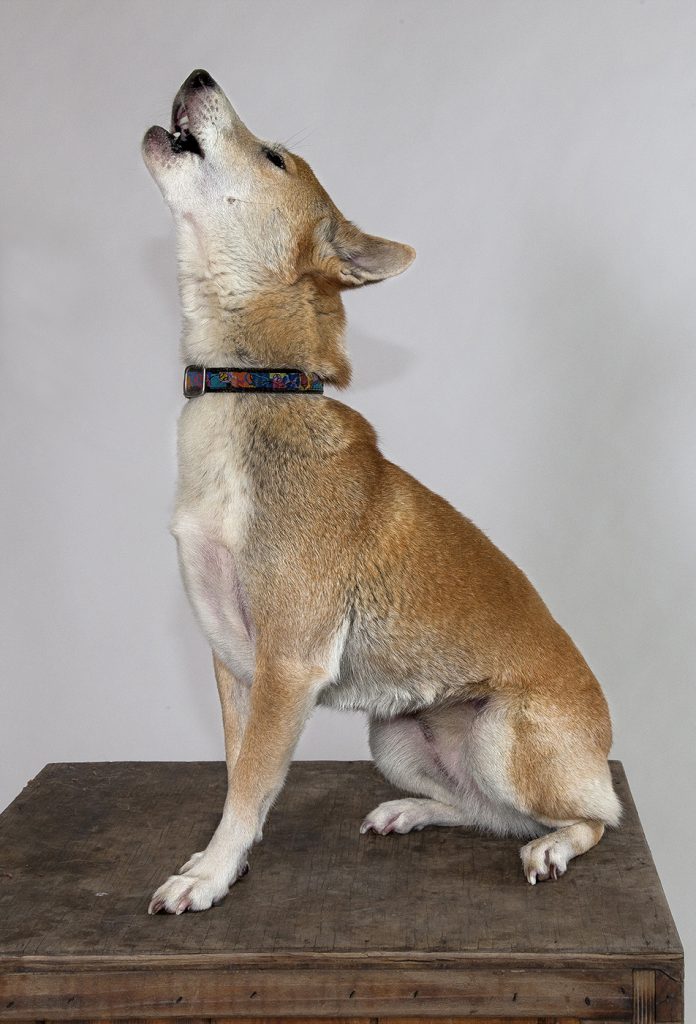
YODEL-AY-DEE-OOOO
New Guinea singing dogs, like the Zoo’s animal ambassador Montana, communicate with a melodious howl that sounds very much like a yodel.
 Average weight of an adult singing dog, in pounds
Average weight of an adult singing dog, in pounds
New Guinea singing dogs are not pack animals: they are solitary, although they defend their territory in mated pairs and raise their pups together. The singing dog and the dingo are believed to have descended from the same prehistoric dog ancestor to become domesticated dogs at one time, but they now have a long history of living independently of humans.
Few singing dogs are thought to still exist in the wild and they are listed as vulnerable on the IUCN Red List. Threats to their existence include loss of habitat, inbreeding of the small population, and hybridization with domestic dogs that now live in New Guinea.
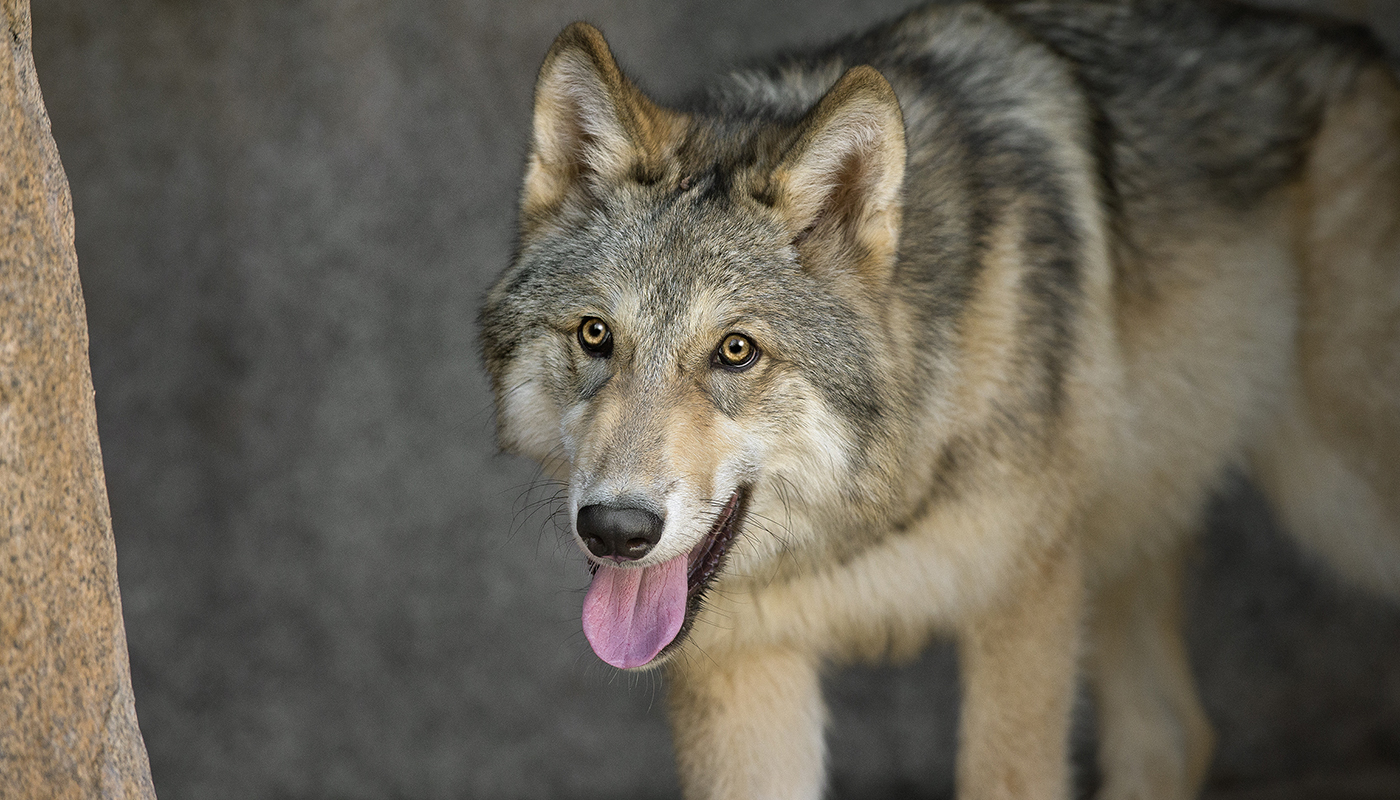
 Number of miles away a wolf’s howl can be heard across the Arctic tundra
Number of miles away a wolf’s howl can be heard across the Arctic tundra
Big, But Not Bad
Wolves Canis lupus live in wilderness areas of North America, northern Europe, and Asia. Like dholes, wolves are carnivores that live in family packs consisting of an alpha male and female and their offspring. The position of their tail indicates dominance or submission; they scent mark to communicate with other wolves; and they hunt together as a pack, allowing them to prey on much larger animals.
However, unlike dholes, wolves communicate in a manner much more like domestic dogs,including barking and howling. They can be big: gray wolves measure 2.8 to 4.3 feet in length and can weigh up to 136 pounds. They also have strong and powerful jaws that can break bones, and teeth that can easily rip through tough animal hides.
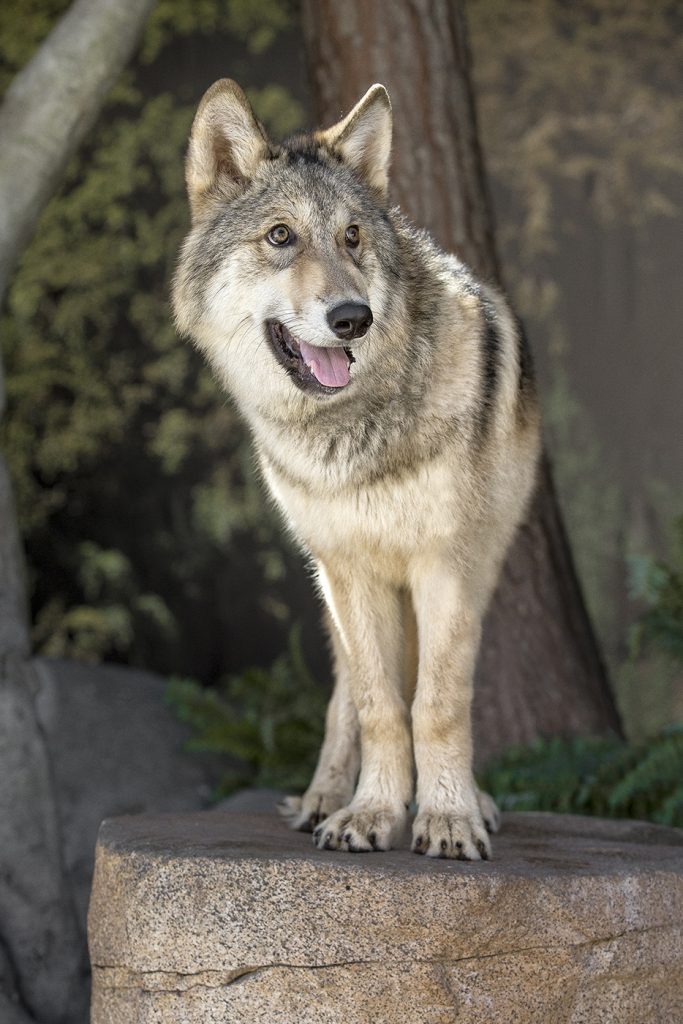
TELLING HIS STORY
When Zoo guests meet an animal ambassador like Shadow the gray wolf, they learn that real wolves are nothing like the big, bad characters in storybooks.
 Number of pounds of jaw pressure per square inch in a wolf’s bite
Number of pounds of jaw pressure per square inch in a wolf’s bite
Although wolves are fast and efficient hunters, a pack of wolves tends to take down the oldest, sickest, or weakest members of a herd. In doing so, they play a crucial role in their ecosystem, keeping populations of prey animals healthy and balanced in numbers. While wolves can be fierce hunters, their centuries-old reputation as vicious maneaters—enshrined in thousands of children’s storybooks—is undeserved.
The Zoo has had several wolves as animal ambassadors over the years. Currently, a gray wolf animal ambassador named Shadow helps guests learn the truth about his species and the challenges wolves face in their natural habitats. Shadow, born in 2014, was raised at the Zoo.
The biggest threats to wolves in the wild are habitat loss and confrontations with humans who are protecting livestock. Wolves are considered vulnerable or endangered in many locations, and they tend to do best in remote wilderness areas where they can avoid contact with people.
Speaking Canid-ly
When you compare wild dogs and wolves to domesticated dogs, there are many common characteristics. But they are very different—and the natural behaviors that wild canids display at the Zoo and Safari Park are just as fascinating to watch as any trick a trained domestic dog could perform on YouTube. Check out our canids, and see for yourself!

